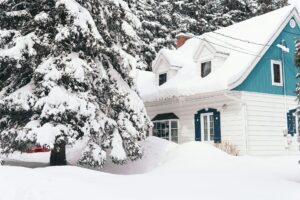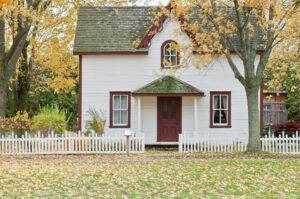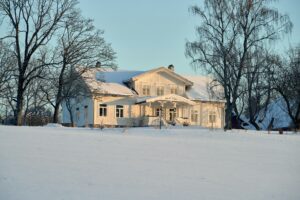Moss might seem like a small issue, but in Bend’s high desert climate, it has a surprising knack for taking hold and causing serious damage, especially when paired with November’s dropping temperatures. Many people associate moss problems with damp, humid regions like Portland or Salem, yet Bend presents its own unique obstacles. During the winter freeze, moisture can become locked beneath patches of moss, undermining roof shingles and accelerating deterioration. November marks a critical window to handle this issue before the deeper cold sets in, giving you the best chance of preventing extensive damage.
In this guide, you will discover why November is the perfect month for roof moss removal in Bend, how to protect a roof from winter’s freeze-thaw cycle, and specific methods for lasting moss prevention. A robust comparison table of treatment options highlights cost, effectiveness, and environmental considerations, while an FAQ section answers key questions about Bend roof moss removal. By the end, you will have a practical step-by-step plan to protect your investment and keep your roof intact through the winter.
Why November Is the Critical Month for Moss Treatment in Bend
For many homeowners, moss barely crosses the mind during the mild days of early fall. However, November in Central Oregon often brings abrupt temperature changes and shifts in weather patterns. By late November, Bend typically experiences its first hard freeze, temperatures dipping well below 32°F at night. If moss is left on your roof at that point, moisture can become trapped underneath, where freeze-thaw cycles constantly expand and contract, weakening shingles and causing them to lift, crack, or curl.
- During November 1-20, daytime temperatures remain high enough for moss removal solutions to work effectively.
- Once the freeze hits, removing moss becomes harder and may lead to additional shingle damage if done improperly.
Acting now, rather than waiting until spring, prevents moisture from seeping deeper into shingles and saves considerable repair costs later. This straightforward measure is essential for any Central Oregon homeowner aiming to preserve the lifespan of their roof.
How Freeze-Thaw Cycles Worsen Moss Damage Through Winter
Bend’s winter days frequently start near freezing and then warm up as the hours progress, a daily pattern that puts stress on all roof materials. When moss is involved, the damage can be more pronounced:
- Moss holds water, and sub-freezing temperatures cause that water to expand within the shingle layers, prying them apart over time.
- When the temperature rises, the melted water seeps into small openings or cracks in the roofing material.
- Repetitive expansion and contraction lifts shingles, warps them, or erodes protective granules at an accelerated rate.
Small cracks or slightly lifted edges become gateways for more moisture, which promotes new or continued moss growth. Letting moss remain past the first hard freeze makes it more difficult to remove without risking further shingle damage.
Bend’s High Desert Climate and Unique Moss Growth Patterns
While Bend’s drier, high-desert air differs from the moist Willamette Valley, moss can still take root in shaded or cool areas. Research from Oregon State University on moss growth patterns shows that moss requires only minimal moisture, some shade, and organic debris to get started.
- Shaded spots beneath overhanging trees or on north-facing sections of the roof tend to stay damp longer, leading to ideal moss-friendly conditions.
- Even though Bend sees fewer inches of annual rainfall, moss can thrive after just a few days of rain if conditions remain cool and shaded.
- Intense UV exposure can dry out moss areas on some surfaces, yet thick patches in sheltered areas stay moist and continue to grow or spread.
Moss reproduces through spores, so a small patch of growth can quickly expand if left untreated. In November, heightened moss growth often appears after autumn rains, right before temperatures plummet. Tackling small patches early ensures they do not go dormant through winter and then resurge during spring thaws.
Moss Treatment Methods Choosing the Right Approach
Your moss treatment plan should be shaped by your budget, the extent of growth, roof type, and environmental concerns. Weigh the pros and cons of each method in the table below:
| Treatment Method | Cost | Effectiveness | Longevity | Roof Material Compatibility | Environmental Impact | Best For |
|---|---|---|---|---|---|---|
| Chemical Treatment | $300-$600 | High (90-95%) | 2-3 years | Most materials | Moderate (runoff concerns) | Immediate results |
| Manual Removal | $400-$800 | Very High (98%) | 1-2 years | All materials | Low | Heavy buildup |
| Zinc/Copper Strips | $500-$1,200 | Moderate (70-80%) | 10-15 years | Asphalt, composite | Very Low | Long-term prevention |
| Roof Replacement | $8,000-$20,000 | Complete (100%) | 20-30 years | N/A (new material) | Variable | Severe damage |
Chemical sprays offer fast results but may raise concerns about environmental runoff. Manual removal is thorough and immediate, especially for heavy moss buildup, though it can be labor-intensive. Zinc or copper strips installed near the roof peak provide a slow-release method for preventing moss regrowth, manufacturer recommendations highlight how these metals continuously release ions that discourage moss spores.
Professional Moss Removal vs. DIY in Central Oregon
Homeowners often weigh the option of doing moss removal themselves against hiring professionals. While a DIY approach may save money, the complexities of Bend’s winter climate introduce potential pitfalls:
- Managing the work yourself can be time-consuming, especially if an extensive infestation covers multiple sections of the roof.
- Improper chemical application risks runoff issues or damage to plants and other property areas.
- Slippery or icy conditions on the roof elevate the risk of ladder falls or potential injury.
For Bend residents seeking speed and certainty, partnering with trusted roofing specialists can make a dramatic difference in both safety and outcome. Professionals assess your roof materials, pinpoint the ideal moss treatment technique, and schedule work during Bend’s prime pre-freeze window.
Prevent winter damage and protect your Bend roof today. HomeMasters offers professional moss treatment and prevention services. Get Free Assessment
Zinc and Copper Strips for Long-Term Prevention
A sustainable component of moss control involves installing zinc or copper strips along the ridgeline. These metals gradually release ions when it rains, making the roof surface inhospitable to moss over the long term. While not a speedy fix for existing infestations, strips work well once the roof has been thoroughly cleaned:
- Zinc strips are often less expensive but can produce some streaking or discoloration.
- Copper strips tend to cost more yet typically last longer and cause fewer aesthetic issues.
- Proper installation at the highest point sends ions flowing across the shingles, protecting them efficiently during rain or snowmelt.
Although Bend’s dry climate may slow ion release, the rainy and snowy months provide enough water flow to keep moss at bay. For current growth, clear the moss first to let these strips do their job over time.
Roof Material Susceptibility Asphalt, Metal, and Tile
Vulnerability to moss varies among roofing materials. Asphalt shingles are most common in Bend and can be particularly susceptible if moss is ignored. Small granules on asphalt can easily break away when moss expands beneath them, allowing water infiltration.
- Asphalt, Prone to accelerated granule loss, lifting edges, and damage from freeze-thaw cycles.
- Metal, Less susceptible overall, but debris that gathers in seams or ridges can eventually foster moss growth.
- Tile, Typically more resistant, but moss can grow in grout lines or small gaps and expand with freeze-thaw activity.
If you are considering a new roof, choosing the right roofing material for Bend can reduce moss issues later. Regardless, annual inspections and preventive steps are critical for all roofing types.
Cost Analysis Prevention Now vs. Replacement Later
Investing in moss prevention can save thousands down the line. Severe roof replacement, triggered by advanced moss damage, may range from $8,000 to $20,000 depending on the size of your home and chosen materials. By contrast, moss removal and prevention are far more affordable:
- Timely chemical or manual moss removal in November usually costs $300 to $800 for typical Bend homes.
- Adding zinc or copper strips runs $500 to $1,200, providing a decade or more of protection.
- Entire roof replacement becomes a last resort if the moss has significantly weakened shingles and underlayment.
Dealing with moss before the first major freeze grants peace of mind, knowing your roof is prepared for Bend’s winter extremes.
Environmental Considerations for Moss Treatment in Bend
Bend’s beautiful natural setting inspires a desire to protect the environment. If you prefer a chemical approach to moss control, EPA guidelines recommend these best practices:
- Use chemicals minimally and follow the label closely to reduce runoff.
- Opt for milder, environmentally responsible products where possible.
- Prioritize manual removal or metal stripping if you live near a sensitive watershed.
Although Bend’s dryness lessens runoff concerns compared to wetter regions, freeze-thaw cycles can generate meltwater that can carry chemicals into unwanted areas. A balanced, mindful approach ensures you safeguard your roof and the local ecosystem.
FAQ Your Bend Moss Control Questions Answered
- When is the best time for moss removal in Bend before winter? Early November through about November 20 is ideal. Daytime temperatures remain warm enough for treatments to penetrate moss effectively, and the first significant freeze often arrives by late November.
- What damage can moss cause to my asphalt shingles if I wait until spring? Moss retains moisture. When that moisture freezes, it expands, lifting and cracking shingles. This creates leaks, structural problems, and potentially high repair costs.
- How do zinc strips keep moss at bay on Central Oregon roofs? Rain or snowmelt activates zinc ions that flow down the shingles, forming a moss-hostile environment. Over time, this regular flow significantly curtails moss growth near the strips.
- Is chemical moss treatment suitable for Bend’s high-UV environment? Professionally formulated products are designed to work in diverse climates. Always follow product directions or consult local specialists who understand Bend’s elevated UV levels.
- What is the average cost of hiring a professional for moss removal in Bend? Removing moss from a standard 2,000-square-foot roof typically runs between $400 and $800, factoring in the degree of infestation and roof complexity.
- Can I handle moss removal myself, or should I hire a pro in Bend? A DIY approach is possible with the right equipment and precautions. However, icy conditions and chemical application hazards make professional services safer and generally more thorough.
- Are metal roofs in Bend prone to the same moss problems as asphalt shingles? Metal roofs are less susceptible, but debris buildup in seams or ridges can lead to moss. Routine inspection and cleanup help prevent these pockets of growth.
Schedule Your Bend Moss Treatment
November is closing fast, secure your roof before winter’s freeze locks in potential moisture damage. Schedule your Bend moss treatment to lock in a treatment date online. Acting now delivers peace of mind all season, preventing costly headaches as the freeze-thaw cycles intensify.
With a proactive moss-control strategy, you spare yourself the unwelcome expense of major structural damage, maintain your roof’s clean appearance, and ensure a dry, secure home for years to come. Incorporating maintenance steps like installing zinc strips and scheduling annual inspections transforms roof care from an emergency chore into a seamless, preventative practice. In Bend’s dynamic climate, this adaptability ensures long-term protection and confidence in your home’s resilience.




